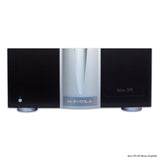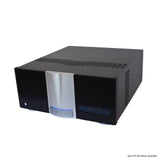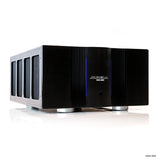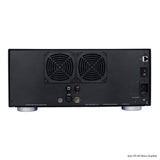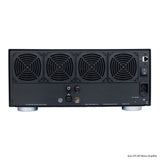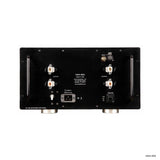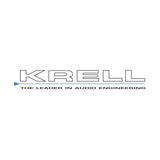Krell
Krell Mono Amplifiers
- Solo 375 XD
- Solo 575 XD
KMA-i800
The KMA-i800 is a state-of-the-art 800 watt monaural amplifier. It incorporates Krell’s most advanced circuit topologies and Krell’s proprietary technologies iBias, XD, and Sym-Max.
This gives the KMA-i800 a warm enveloping three-dimensional sound with unparalleled detail, along with the rock-solid bottom end and effortlessness that Krell is known for.
Solo 375 XD & Solo 575 XD Mono Amplifiers
Krell's New XD Technology
Krell’s “XD” (Xtended Dynamics, Xtended Dimensionality, Xtended Detail) upgrade for the iBias amplifiers takes an already great sounding amplifier and raises its performance to the next level. “XD” is a classic example of Krell’s continuous R&D efforts reaping benefits across multiple product lines. During the development of the K-300i Integrated Amplifier we discovered substantial sonic improvements by lowering the output impedance below traditional norms. So we applied this technique to our existing line of amplifiers and the improvement was so substantial that it required a unique designation, hence, “XD.”
It was no simple matter to just lower the output impedance. This affects the amplifier’s stability and transient response so each stage prior to the output stage had to be re-tuned to work optimally with the lower output impedance. This lower output impedance exerts more control over the speaker drivers and damps out unwanted vibrational modes, allowing a more accurate reproduction of the original signal.
Krell Class A iBias Technology
Krell's history is rich with breakthrough Class A amplifiers that have helped build the Krell legacy of offering the best sounding amplifiers available. Audiophiles have always considered Class A technology to be the best sounding operating state for amplifiers. However, despite Class A's unrivaled sound quality, it has fallen out of fashion because of recent demands to reduce power consumption and heat in home electronics products. Krell engineering took this challenge and redefined the meaning of high performance power amplifier. Our goal – unmatched performance, elegant design, and a compelling array of features. The breakthrough - a patent pending circuit delivering Class A operation without the excessive heat and wasted energy of conventional designs, housed in a striking new form factor, with network connectivity for advanced access and monitoring. The sound is open and unconstrained, in a manner that rivals live performance and the true sound of voices and instruments. Music and dialogue are reproduced with a richness, detail, and startling dynamics that fill a room.
Plainly stated, Class A designs are the most musically accurate circuit topology available. Class A amplifiers do not suffer from the inherent distortions that all Class AB amplifiers experience. In a traditional Class A design, the output transistors conduct full current at all times regardless of the actual demand from the speakers. Often, only a fraction of this power is needed to reproduce an audio signal at normal listening levels. The rest of the power is dissipated through the amplifier’s heat sinks, producing large amounts of wasted heat. With Krell's iBiasTM technology, bias is dynamically adjusted, so the output transistors receive exactly as much power - but only as much power - as they need.
Krell's iBias Class A technology allows their latest amplifiers to run in full Class A mode to full power while minimizing heat generation. Previous efforts at using a "tracking" bias, while effective, only measured the incoming signal and set bias levels from this information. Krell's new patent pending iBias technology significantly elevates the effectiveness of previous designs by calculating bias from the output stage. This seemingly small change in topology results in a dramatic improvement in sound quality, especially midrange richness and purity.
The core of the technology is an innovative, patent pending design for a dynamic intelligent bias circuit. Krell's iBias Class A circuit directly measures the output current of the amplifier and adjusts the bias to the optimum level. Because iBias Class A measures the output current, the real time demands of the specific speaker connected to the amp are directly incorporated into the circuit function. In addition, iBias Class A even reduces the bias when the signal is at very low levels, making its operation undetectable by ear and even by standard amplifier measurements.
In sliding bias schemes, the circuit merely estimates how much bias is needed based on the input signal and an "assumed speaker load." Compared with iBias Class A, these sliding bias technologies are much less effective - and much less accurate.
Power Supply Highlights
Power supply technology has always been an important contributor to the Krell sound. The power supplies of their Krell iBias Class A amplifiers have been optimized for use with the iBias circuit. Depending on the model, up to four toroidal transformers feed amplifier modules that include the audio circuitry, rectifier, and power supply filtering mounted to an individual heat sink. This design shortens the electrical path from the power supply to the output transistors, reducing the overall impedance and allowing the circuit to respond faster and control the speakers even better and more accurately.
Unlike traditional Class A amplifiers, iBias Class A amps have a compact design that allows rack-mounting, making them ideal for custom installation as well as traditional audiophile systems. This convenient form factor is made possible through thermostatically controlled ventilation fans. The fans used are specifically chosen for quiet operation, and operate at the speed required to maintain the ideal internal temperature. They run only during periods of peak energy demand - when the music is at its loudest - so they are inaudible in normal use.
Network Connectivity
The new amplifiers include RJ 45 Ethernet connectivity and an internal web page that is accessible from any smartphone, tablet, or laptop. Network connectivity brings convenience, monitoring, and reporting to end users. Amplifier configuration options include display brightness and timeout. For energy conservation, the amplifiers can be programmed to power off at a preset time of inactivity. Individual channels can be muted and firmware updates can be initiated from the web server.
Once the amplifier is connected to a network router with Internet access, the amplifier's advanced protection systems are now viewable on an Internet-connected device. Excessive current, output DC, fan speeds, short circuit, and overheating are all monitored in real time. If an issue occurs, the fault is displayed on the front panel and reported on the web server interface. Emails will automatically be sent to as many as three email addresses to notify the end user and/or the dealer of the condition.
Circuitry Highlights
The new iBias circuitry is built on a foundation of core Krell circuit technologies. All signal gain is realized in the current domain using proprietary multiple-output current mirrors with extraordinary open loop linearity. Each amplifier channel uses all discrete components. There are no generic integrated circuits or op amps used anywhere. Gain is distributed among several stages, allowing each to have a large linear operating area.
Audio signal voltages are converted to current at the amplifier input, and the audio signal remains in the current domain throughout the entire amplifier.
Current mirrors in the final gain stages use a new output power device that operates at a 73% higher voltage, delivers almost 10% more current, and offers 120 watts of additional power handling capability as compared to other devices. With this combination, the iBias amplifiers may now deliver substantially more power while using a smaller footprint. Normally used in demanding, high-bandwidth video circuits, these transistors allow the design of gain stages with superb accuracy and very low distortion. The signal path is fully complementary and fully balanced from input to output. Independent complementary pre driver and driver stages for the positive and negative output transistors make the output stages extremely fast and linear. This unique circuit is impervious to low-impedance or reactive loads; it simply drives any loudspeaker with absolute confidence, achieving the very best possible sonic results.
Most amplifiers use coupling capacitors in the signal path to block DC and prevent damaging offset voltages from reaching your speakers. Krell amplifiers are fully direct-coupled, with no capacitors in the audio signal path. This design gives the Krell amplifiers lower internal impedance, which allows firmer, more precise control of your speakers. It also provides flatter, more extended low-frequency response, because coupling capacitors not only block DC but also affect the lowest bass frequencies. Krell employs expensive, non intrusive DC servos that remove DC without impacting the musical signal. Thus, the iBias Class A amplifiers deliver the full breadth of the music with detail, impact, and space intact.
Krell CAST TM
Reserved for the Solo 375 and Solo 575 is Krell's CAST inputs and circuitry. Current Audio Signal Transmission, termed CAST, is a revolutionary method of connecting analog audio components for unparalleled sonic performance. In traditional audio systems, each component is a discrete entity with unique characteristics that act upon the musical signal independently. Each component is unaware of the other components in the system. The cables that connect the components also have their own electrical characteristics, which affect the sonic presentation of the entire system. Krell CASTTM unifies individual components and interconnects them into an electrically linked whole. The original signal remains unaltered from source to speaker. Still equipped with standard connections for use with other components, the full expression of Krell technology is realized when the system is connected using Krell CAST MMF interconnects. Krell CAST connected systems offer significant improvements in every performance area: speed, precision, dynamic range, depth and width of the sound stage, transient impact, and tonal balance.
Everything Audiophiles and Home Theater Fans Could Want in an Amplifier.
Krell iBias Class A amplifiers are the first to deliver the rich musicality of Class A amplifiers, the uncompromising dynamics of classic Krell amplifiers, and the efficiency and low power consumption of Class G and H amplifiers. Because the iBias circuit eliminates crossover distortion, the amplifier is able to resolve more of the detail and micro- dynamics in even the best analog recordings. Simply put, the music breathes. Whether an iBias amplifier is called on to reproduce the extreme dynamic range of high-resolution digital files, the minute intricacies of a 45-rpm, 180- gram vinyl record, or the complexity of today’s latest blockbuster action film, it does so without altering or abating the music in any way.
The iBias amplifiers' unprecedented ability to retrieve the subtlest details gives their sound an incredible dimensionality, with an ambient, broad and extraordinarily deep soundstage. As spacious as the sound is, though, the amplifiers are still able to produce pinpoint stereo imaging if the recording calls for it.
It's all the power and control for which Krell has always been famous, with a level of resolution and musicality in the midrange and treble that has simply never been heard before.
In short, the new patent pending iBias Class A Krell amplifiers give today's audiophiles and home theater fans everything they could possibly want in an amplifier.
KMA-i800 Mono Amplifier
Differential Output
The KMA-i800 is a differential output amplifier. This means it contains two identical amplifiers operating out of phase to produce an output signal twice as large as a single amplifier. The main advantage of this configuration is cancelation of common-mode distortion and noise components. The KMA-i800 also incorporates special compensation to maintain very low output impedance at the low end of the frequency range. This produces high impact extended bass that is felt as much as it is heard.
iBias
iBias enables the KMA-i800 to operate in Class A up to its full rated power of 800 watts with absolute accuracy but without the heat produced by a traditional Class A design. It does this by using a novel circuit to unobtrusively monitor the current flowing through the output stage. This is part of a closed-loop controller that makes sure this current never drops below a preset level (Class A means that it never drops to zero). This is what makes the amp both efficient and accurate.
The efficiency comes from the controller adjusting the bias to maintain that low preset current level as the signal and speaker load changes. Traditional Class A amplifiers set it for the maximum level all the time so they’re always dissipating the maximum amount of heat. iBias is like having a variable size Class A amplifier. If, for example, the signal and speaker are only requiring 10 watts, it’s like having a 10 watt Class A amplifier, all the way up to 800 watts in the case of the KMA-i800.
The accuracy also comes from maintaining that low preset current level. It doesn’t matter what the signal is doing or how the speaker impedance changes with frequency, by maintaining that preset current level the amplifier is always operating in Class A. Other variable bias schemes monitor the input or output signal to adjust the bias but that doesn’t take into account varying speaker impedance. This means they will sometimes apply more bias current than necessary or drop out of Class A operation.
XD
XD is a technique for lowering the amplifier’s output impedance. This results in better control over the speaker drivers which improves musical dynamics, depth, and dimensionality. It is very dependent on maintaining thermal equilibrium in the output stage so that all the output transistors are contributing equally to the signal output. The KMA-i800 uses a massive aluminum device bar to mount the output transistors and also employs special temperature compensation across the device bar to limit temperature variations.
Sym-Max
Sym-Max is short for “Symmetry Maximization.” The circuitry in the KMA-i800 is differential, meaning that there is a positive half and a negative half. The transistors in this circuitry are complimentary, meaning opposite polarity but with equal characteristics. In practice they are not so equal which means the circuit is operating asymmetrically. Sym- Max makes small adjustments in the circuit parameters to remove this asymmetry. The result is that 2nd order harmonic distortion is almost completely eliminated. This dramatically opens up the sound stage with more detail and a better sense of pacing, making for a more realistic experience.
Power Consumption
The heart of any power amplifier is the power supply. The KMA-i800 has a massive power supply consisting of 5800VA of transformers and 188,000uF of filter capacitance. Delivering this power to the output circuit is a combination of gold-plated circuit boards and silver-plated solid copper buss bars with a very short physical path for extremely low impedance. This, along with the audio circuitry enables the KMA-i800 to double its power from 800 watts into 8 ohms to 1600 watts into 4 ohms and even 3200 watts into 2 ohms. It can drive 1 ohm speakers and will deliver a peak current of up to 56 amps.
Circuitry
The KMA-i800 uses Krell Current-Mode circuitry with advanced current mirroring that is balanced, differential, and direct-coupled. Each stage is independently tuned and matched to the previous stage for optimal operation. The output stage consists of 16 pairs of 200 watt audio power transistors and 8 pairs of audio driver transistors. This results in a frequency response greater than 100kHz for effortless reproduction of the audio band.
Control and Protection
The KMA-i800 is microprocessor controlled and has Ethernet connectivity and a 12VDC trigger input for easy connection to a home controller. The Ethernet connection allows access to the KMA-i800 web page for status information and control. The KMA-i800 is protected against high DC on the outputs, output short circuit conditions, and power brown outs. The protection operation is conveniently indicated on the front panel status lights and the web page.
Solo 375 XD
| Frequency Response | : | 20 Hz to 20 kHz +0, -0.15 dB |
| : | 0.5 Hz to 100 kHz +0, -3 dB | |
| Signal-to-noise ratio | : | >108 dB, wideband, unweighted, referred to full power output |
| : | >114 dB, "A"-weighted | |
| Gain | : | 27 dB |
| Total Harmonic distortion | : | <0.03% at 1 kHz, at 375 W, 8 Ω |
| : | <0.19% at 20 kHz, at 375 W, 8 Ω | |
| Input Impedance | : | Single-ended: 100 kΩ |
| : | Balanced: 200 kΩ | |
| Input Sensitivity | : | Single-ended or balanced: 2.45 V RMS |
| OutputPower | : | 375 W RMS at 8 Ω |
| : | 600 W RMS at 4 Ω | |
| Output Voltage | : | 152 V peak-to-peak |
| : | 55 V RMS | |
| Output Current | : | 17 A peak |
| Slew Rate | : | 40 V/μs |
| Output Impedance | : | <0.045 , 20 Hz to 20 kHz |
| Damping Factor | : | >177, 20 Hz to 20 kHz, referred to 8 Ω |
| Power Consumption | : | Standby: 1 W |
| : | Idle: 66 W | |
| : | Maximum: 1150 W | |
| Heat Output | : | Standby: 3.42 BTU/hr. |
| : | Idle: 225 BTU/hr. | |
| : | Maximum: 3933 BTU/hr. | |
| Inputs | : | 1 single-ended via RCA connector |
| : | 1 balanced via XLR connector | |
| : | 1 x CAST | |
| Outputs | : | 1 pairs binding posts |
| Dimensions | : | 43.4 x 19.4 x 53.6 cm (WxHxD) |
| Weight | : | 31.8 kg (shipping) |
| : | 37.3 kg (unit only) |
Solo 575 XD
| Frequency Response | : | 20 Hz to 20 kHz +0, -0.15 dB |
| : | 0.5 Hz to 100 kHz +0, -3 dB | |
| Signal-to-noise ratio | : | >108 dB, wideband, unweighted, referred to full power output |
| : | >115 dB, "A"-weighted | |
| Gain | : | 27 dB |
| Total Harmonic distortion | : | <0.03% at 1 kHz, at 575 W, 8 Ω |
| : | <0.19% at 20 kHz, at 575 W, 8 Ω | |
| Input Impedance | : | Single-ended: 100 kΩ |
| : | Balanced: 200 kΩ | |
| Input Sensitivity | : | Single-ended or balanced: 3.03 V RMS |
| OutputPower | : | 575 W RMS at 8 Ω |
| : | 900 W RMS at 4 Ω | |
| Output Voltage | : | 192 V peak-to-peak |
| : | 68 V RMS | |
| Output Current | : | 22 A peak |
| Slew Rate | : | 40 V/μs |
| Output Impedance | : | <0.045 , 20 Hz to 20 kHz |
| Damping Factor | : | >216, 20 Hz to 20 kHz, referred to 8 Ω |
| Power Consumption | : | Standby: 1 W |
| : | Idle: 131 W | |
| : | Maximum: 2660 W | |
| Heat Output | : | Standby: 3.42 BTU/hr. |
| : | Idle: 448 BTU/hr. | |
| : | Maximum: 9097 BTU/hr. | |
| Inputs | : | 1 single-ended via RCA connector |
| : | 1 balanced via XLR connector | |
| : | 1 x CAST | |
| Outputs | : | 1 pairs binding posts |
| Dimensions | : | 43.4 x 19.4 x 53.6 cm (WxHxD) |
| Weight | : | 36.4 kg (shipping) |
| : | 31.8 kg (unit only) |
KMA-i800
| Analog Inputs | : | 1 balanced via XLR connector |
| : | 1 single-ended via RCA connector | |
| Outputs | : | 2 pr. speaker outputs via gold-plated binding posts |
| Control Inputs | : | 1 Ethernet via RJ45 |
| : | 1 12 VDC trigger input via 2-conductor 3.5 mm connector | |
| Input Impedance | : | Balanced: 28 kΩ |
| : | Single-ended: 14 kΩ | |
| Frequency Response | : | 20 Hz to 20 kHz +0, -0.13 dB |
| : | -3dB bandwidth 147kHz (measured at 50W into 8Ω) | |
| Signal-to-Noise Ratio | : | >109 dBr, wideband, unweighted, referred to full power output |
| : | >120 dBr, “A”-weighted | |
| Gain | : | 26.5 dB |
| Input Sensitivity | : | 3.8 V RMS |
| Total Harmonic Distortion | : | <0.010%, 1 kHz, 800W, 8Ω load |
| : | <0.035%, 20 kHz, 800W, 8Ω load | |
| Output Power | : | 800W RMS at 8Ω |
| : | 1600W RMS at 4Ω | |
| Output Voltage | : | 245 V peak to peak |
| : | 86 V RMS | |
| Output Current | : | 56 A peak |
| Slew Rate | : | 35 V/μs |
| Output Impedance | : | 0.009 Ω, 20 Hz |
| : | 0.018 Ω, 1 kHz | |
| Damping Factor | : | >800, 20 Hz referred to 8 Ω |
| : | >400, 1kHz referred to 8 Ω | |
| Power Consumption | : | Standby: 1 W |
| : | Idle: 260 W | |
| : | Maximum: 4750 W (4Ω load) | |
| Heat Output | : | Idle: 890 BTU/hr |
| : | Maximum: 10,773 BTU/hr (4Ω load) | |
| Dimensions | : | 43.8 x 23.9 x 61 cm (WxHxD) |
| Weight | : | 66 Kg (unit only) |
| : | 82 Kg (shipping weight) |








